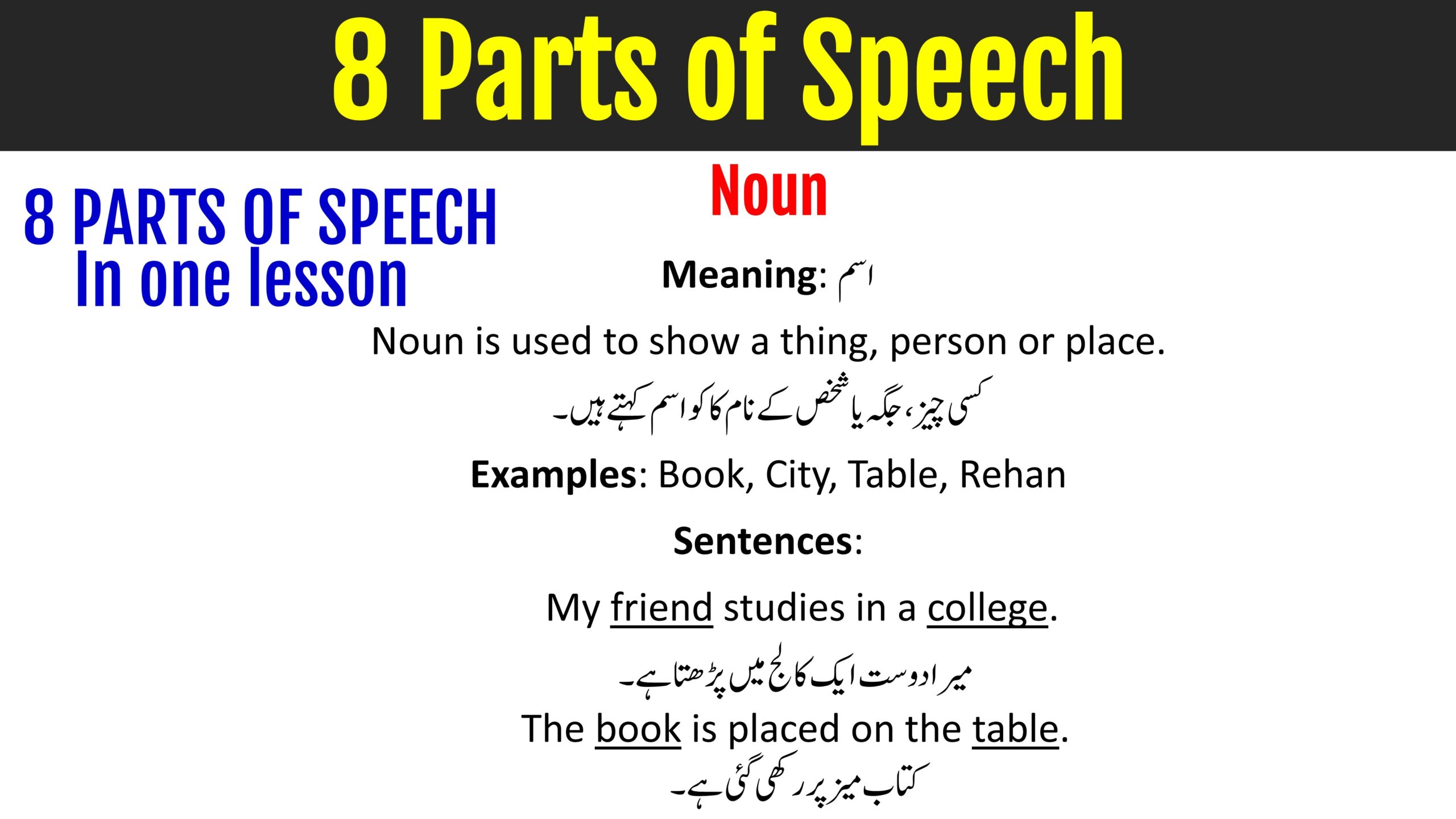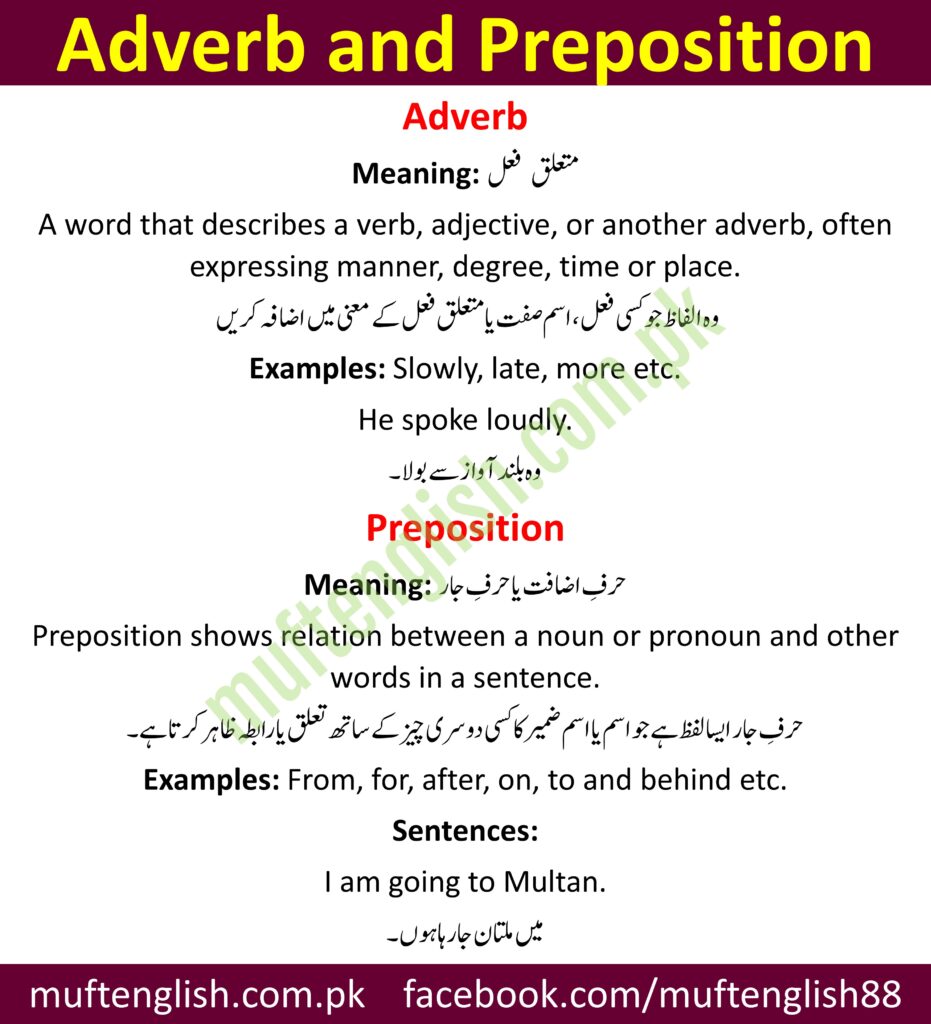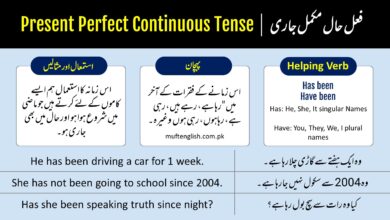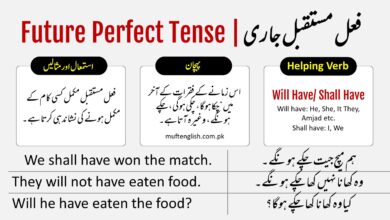8 Parts of Speech in English and Urdu with Examples

Parts of Speech in English and Urdu with Examples
A sentence consists of many words and these words are divided into many parts and those parts are called parts of speech.
There are basically 8 parts of speech.
| Noun | اسم | Pronoun | اسم ضمیر |
| Adjective | اسم صفت | Verb | فعل |
| Adverb | متعلق فعل | Preposition | حرف جار |
| Conjunction | حرف عطف | Interjection | حرف ندا |
Noun
Meaning: اسم
A noun is used to show a thing, person or place.
کسی چیز، جگہ یا شخص کے نام کا کو اسم کہتے ہیں۔
Examples: Book, City, Table, Rehan
Sentences:
- My friend studies in a college.
میرا دوست ایک کالج میں پڑھتا ہے۔
- The book is placed on the table.
کتاب میز پر رکھی گئی ہے۔
- Ali is playing football.
علی فٹبال کھیل رہا ہے۔
Pronoun
Meaning: اسم ضمیر
A pronoun is a word used instead of a noun in the sentence to avoid repetition in the sentence.
اس کو ہم اسم کے جگہ جملے میں استعمال کرتے ہیں۔
Examples: I, you, He, She, It, etc
Sentences:
- He is coming right now.
وہ ابھی آرہا ہے۔
- She has brought the dress.
وہ لباس لے آئی ہے۔
- I am seeing him.
میں اسے دیکھ رہا ہوں۔
Table of Personal Pronouns
Personal Pronouns of the First Person – صیغہ متکلم
| Number and Gender | Nominative Case (فاعلی حالت) | Possessive Case (ملکیتی حالت) | Objective Case (مفعولی حالت) |
| Singular (masculine and feminine) | I | My, Mine | Me |
| Plural (masculine and feminine) | We | Our, Ours | Us |
Personal Pronouns of the Second Person – صیغہ حاضر
| Number and Gender | Nominative Case (فاعلی حالت) | Possessive Case (ملکیتی حالت) | Objective Case (مفعولی حالت) |
| Singular (masculine and feminine) | You | Your, Yours | You |
| Plural (masculine and feminine) | You | Your, Yours | You |
Personal Pronouns of the Third Person – صیغہ غائب
| Number and Gender | Nominative Case (فاعلی حالت) | Possessive Case (ملکیتی حالت) | Objective Case (مفعولی حالت) |
| Singular masculine | He | His | Him |
| Singular feminine | She | Her, Hers | Her |
| Singular neuter | It | Its | It |
| Plural common | They | Their, Theirs | Their |
Verb
Meaning: فعل
A verb is a word that shows an action or state.
یہ حالت کو بیان کرتا ہے یا کسی کام کے ہونےکو۔
Examples: play, read, sing, is, are, am
Sentences:
- He is (state)
وہ بیمار ہے۔
- Write a letter to him. (action)
اس کے لئے ایک خط لکھو۔
- They have been playing since the afternoon.
وہ دوپہر سے کھیل رہےہیں۔
Adjective
Meaning: اسم صفت
An adjective is a word that modifies and adds some extra meaning to a noun or a pronoun.
یہ اسم یا اسم ضمیر کے بارے میں مزید اضافہ کرتا ہے۔
Examples: Intelligent, beautiful, wise, etc
Sentences:
- This rose is beautiful.
یہ گلاب خوبصورت ہے۔
- This flower is fragrant.
یہ گلاب خوشبودار ہے۔
- I don’t like cold
مجھے سرد موسم نہیں پسند۔
Adverb
Meaning: متعلق فعل
A word that describes a verb, adjective, or another adverb, often expressing manner, degree, time or place.
وہ الفاظ جو کسی فعل، اسم صفت یامتعلق فعل کے معنی میں اضافہ کریں یہ الفاظ اکثروقت ، جگہ یا کسی کام کے ہونے کے طریقے کو بیان کرتےہیں۔
Examples: Slowly, late, more, etc.
Sentences:
- He spoke loudly.
وہ بلندآوازسےبولا۔
- They fought bravely.
وہ بہادری سے لڑے۔
- They are running quickly.
وہ تیزی سے بھاگ رہےہیں۔
Preposition
Meaning: حرفِ اضافت یا حرفِ جار
A preposition shows the relation between a noun or pronoun and other words in a sentence.
حرفِ جار ایسا لفظ ہے جو اسم یا اسم ضمیرکاکسی دوسری چیز کے ساتھ تعلق یا رابطہ ظاہر کرتا ہے۔
Examples: From, for, after, on, to, and behind, etc.
Sentences:
- I am going to
میں ملتان جارہاہوں۔
- My watch is on the table.
میری گھڑی میز پر ہے۔
- They will reach here at
وہ یہاں غروبِ آفتاب کے وقت پہنچے گے۔
Commonly Used Prepositions with Urdu Meanings
| Behind | پیچھے | About | کے متعلق |
| Over | اوپر – پر | Besides | کے علاوہ |
| Under | نیچے | Beside | ساتھ |
| At, Into, In | میں | After | کے بعد |
| With, By | ساتھ | Within | دوران |
| Upon, At, On | پر | For | کے لئے |
| To | کو | Between, Among | درمیان |
| Of | کا – کے – کی | From | سے |
Interjection
Meaning: حرفِ ندا
An interjection is used to show strong emotions of happiness, sorrow and surprise.
یہ الفاظ فوری جزبے یا دل کےاچانک کیفیت یا احساس کو ظاہرکرتا ہے۔
Examples: Ah!, Alas!, Hurrah!, Hush! etc.
Sentences:
- Hurrah! I got the first position.
آہا! میں نے پہلی پوزیشن حاصل کیا۔
- Alas! I have failed.
افسوس! میں ناکام ہوگیا ہوں۔
- Hush! Don’t make a noise.
خاموش! شورمت مچاؤ۔
Conjunction
Meaning: حرفِ عطف
A conjunction is a word that connects phrases, clauses, or words.
یہ الفاظ لفظوں یا مختصر جملوں کو جوڑتے ہیں۔
Examples: and, or, but
Sentences:
- I am drinking water, but he is hungry.
میں پانی پی رہا ہوں لیکن وہ بھوکا ہے۔
- You either watch something or read a book.
تم کچھ دیکھو یا کتاب پڑھو۔
- I went to have coffee, but the electricity went off.
میں کافی پینے گیا لیکن بجلی گئی۔
A sentence has many words in it and all of them are taken from parts of speech so it means without parts of speech we can neither have a single word nor we can make a sentence. Learning these 8 parts of speech with their definitions and Urdu examples you will be able to differentiate every word and you will know where to place them in a sentence.









It’s very good and I will reads and thanks for you with guide me
Sir
assalam o alakom
Sr m khud Sy English bolny ki koshesh karta hon lakin Sahi jumly BANA NAHI pata.
Sr
Mari grammar bohot ziada kamzor ha m none ki iqsaam or istamal ko Samaj NAHI paraha.
Sr. Plese Mari rehnomai Karen
Sr Kuch log kehty hen k jab talak ap angarezi mahol m NAHI rahogy tab tak ap NAHI sekh paogy.
assalam o alakom Sr m khud Sy English bolny ki koshesh karta hon lakin Sahi jumly BANA NAHI pata . Sr Mari grammar bohot ziada kamzor ha m none ki iqsaam or istamal ko Samaj NAHI paraha . Sr . Plese Mari rehnomai Karen Sr Kuch log kehty hen k jab talak ap angarezi mahol m NAHI rahogy tab tak ap NAHI sekh paogy .